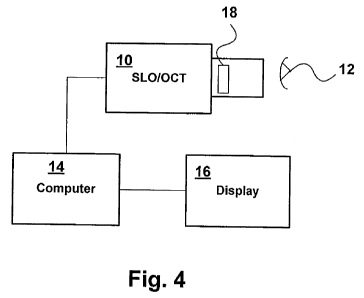Some of the information on this Web page has been provided by external sources. The Government of Canada is not responsible for the accuracy, reliability or currency of the information supplied by external sources. Users wishing to rely upon this information should consult directly with the source of the information. Content provided by external sources is not subject to official languages, privacy and accessibility requirements.
Any discrepancies in the text and image of the Claims and Abstract are due to differing posting times. Text of the Claims and Abstract are posted:
| (12) Patent: | (11) CA 2704350 |
|---|---|
| (54) English Title: | A METHOD FOR PERFORMING VISUAL ACUITY TESTING |
| (54) French Title: | PROCEDE DE REALISATION DE TESTS D'ACUITE VISUELLE |
| Status: | Granted |
| (51) International Patent Classification (IPC): |
|
|---|---|
| (72) Inventors : |
|
| (73) Owners : |
|
| (71) Applicants : |
|
| (74) Agent: | MARKS & CLERK |
| (74) Associate agent: | |
| (45) Issued: | 2016-09-20 |
| (86) PCT Filing Date: | 2008-11-05 |
| (87) Open to Public Inspection: | 2009-05-14 |
| Examination requested: | 2013-09-06 |
| Availability of licence: | N/A |
| (25) Language of filing: | English |
| Patent Cooperation Treaty (PCT): | Yes |
|---|---|
| (86) PCT Filing Number: | PCT/CA2008/001924 |
| (87) International Publication Number: | WO2009/059400 |
| (85) National Entry: | 2010-04-30 |
| (30) Application Priority Data: | ||||||
|---|---|---|---|---|---|---|
|
A visual acuity
examination is performed on a patient by
bringing a confocal imaging apparatus
up to a patient's eye. Stimuli at various
points in the patient's field of view are
generated while the patient fixates on a
point. The patient's responses to the stimuli
are recorded with the movement of the eye
with is tracked with the aid of the confocal
imaging apparatus. The position of said
stimuli on the retina is corrected to take
into account any movement of the eye
between stimuli.
L'acuité visuelle d'un patient est examinée en approchant un appareil d'imagerie confocale d'un il du patient. Des stimuli sont appliqués en différents points du champ de vision du patient tandis que ce dernier fixe un point. Les réponses du patient aux stimuli sont enregistrées avec le mouvement de l'il qui est suivi au moyen de l'appareil d'imagerie confocale. La position de ces stimuli sur la rétine est corrigée pour tenir compte d'un éventuel mouvement de l'il entre les stimuli.
Note: Claims are shown in the official language in which they were submitted.
Note: Descriptions are shown in the official language in which they were submitted.

For a clearer understanding of the status of the application/patent presented on this page, the site Disclaimer , as well as the definitions for Patent , Administrative Status , Maintenance Fee and Payment History should be consulted.
| Title | Date |
|---|---|
| Forecasted Issue Date | 2016-09-20 |
| (86) PCT Filing Date | 2008-11-05 |
| (87) PCT Publication Date | 2009-05-14 |
| (85) National Entry | 2010-04-30 |
| Examination Requested | 2013-09-06 |
| (45) Issued | 2016-09-20 |
There is no abandonment history.
Last Payment of $473.65 was received on 2023-11-02
Upcoming maintenance fee amounts
| Description | Date | Amount |
|---|---|---|
| Next Payment if standard fee | 2024-11-05 | $624.00 |
| Next Payment if small entity fee | 2024-11-05 | $253.00 |
Note : If the full payment has not been received on or before the date indicated, a further fee may be required which may be one of the following
Patent fees are adjusted on the 1st of January every year. The amounts above are the current amounts if received by December 31 of the current year.
Please refer to the CIPO
Patent Fees
web page to see all current fee amounts.
| Fee Type | Anniversary Year | Due Date | Amount Paid | Paid Date |
|---|---|---|---|---|
| Application Fee | $400.00 | 2010-04-30 | ||
| Maintenance Fee - Application - New Act | 2 | 2010-11-05 | $100.00 | 2010-04-30 |
| Maintenance Fee - Application - New Act | 3 | 2011-11-07 | $100.00 | 2011-08-26 |
| Maintenance Fee - Application - New Act | 4 | 2012-11-05 | $100.00 | 2012-09-20 |
| Request for Examination | $200.00 | 2013-09-06 | ||
| Maintenance Fee - Application - New Act | 5 | 2013-11-05 | $200.00 | 2013-10-17 |
| Maintenance Fee - Application - New Act | 6 | 2014-11-05 | $200.00 | 2014-10-15 |
| Maintenance Fee - Application - New Act | 7 | 2015-11-05 | $200.00 | 2015-10-29 |
| Registration of a document - section 124 | $100.00 | 2016-07-22 | ||
| Final Fee | $300.00 | 2016-07-25 | ||
| Maintenance Fee - Patent - New Act | 8 | 2016-11-07 | $200.00 | 2016-11-02 |
| Maintenance Fee - Patent - New Act | 9 | 2017-11-06 | $200.00 | 2017-09-01 |
| Maintenance Fee - Patent - New Act | 10 | 2018-11-05 | $250.00 | 2018-10-15 |
| Maintenance Fee - Patent - New Act | 11 | 2019-11-05 | $250.00 | 2019-10-28 |
| Maintenance Fee - Patent - New Act | 12 | 2020-11-05 | $250.00 | 2020-10-29 |
| Maintenance Fee - Patent - New Act | 13 | 2021-11-05 | $255.00 | 2021-10-27 |
| Maintenance Fee - Patent - New Act | 14 | 2022-11-07 | $254.49 | 2022-11-02 |
| Maintenance Fee - Patent - New Act | 15 | 2023-11-06 | $473.65 | 2023-11-02 |
Note: Records showing the ownership history in alphabetical order.
| Current Owners on Record |
|---|
| OPTOS PLC |
| Past Owners on Record |
|---|
| MCLEAN, DUNCAN |
| OPKO INSTRUMENTATION |
| PEDRO, JUSTIN |
| ROGERS, JOHN |
| WEITZ, RISHARD |